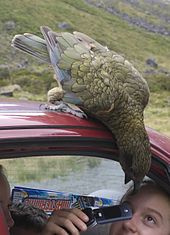Kea
The kea (/ˈkiːə/ KEE-ə; Māori: [kɛ.a]; Nestor notabilis) is a species of large parrot in the family Strigopidae[3] that is endemic to the forested and alpine regions of the South Island of New Zealand.
Kea can solve logical puzzles, such as pushing and pulling things in a certain order to get to food, and will work together to achieve a certain objective.
[10] Eight years earlier, some elderly Māori had told Mantell about the bird, and how it used to visit the coast in winter but had not been seen in recent times.
[25] Juveniles generally resemble adults, but have yellow eyerings and cere, an orange-yellow lower beak, and grey-yellow legs.
Subfossil kea bones have been found in sand dunes at Mataikona in the eastern Wairarapa, Poukawa near Hastings, and Waitomo, indicating that they ranged through lowland forest over much of the North Island until the arrival of Polynesian settlers about 750 years ago.
[28] Kea subfossils are not restricted to alpine areas, being commonly found in lowland or coastal sites in the South Island.
[29] The current distribution of kea reflects the effects of mammalian predators, including humans, which have driven them out of lowland forests into the mountains.
Breeding at heights of 1,600 metres (5,200 ft) above sea level and higher, it is one of the few parrot species in the world to regularly spend time above the tree line.
Nest sites are usually positioned on the ground underneath large beech trees, in rock crevices, or dug burrows between roots.
They are accessed by tunnels leading back 1 to 6 metres (3.3 to 19.7 ft) into a larger chamber, which is furnished with lichens, moss, ferns, and rotting wood.
In addition, Kea also use trial and error tactics and use observational learning to solve difficult problems and when tasked with puzzles and locks.
[43] Tool use behavior has been observed in this species, wherein a bird named Bruce, who has a broken upper beak, wedged pebbles between his tongue and lower mandible and then utilized this arrangement to aid with his preening habits.
James MacDonald, head shepherd at Wanaka Station, witnessed a kea attacking a sheep in 1868, and similar accounts were widespread.
[5] Prominent members of the scientific community accepted that kea attacked sheep, with Alfred Wallace citing this as an example of behavioural change in his 1889 book Darwinism.
For instance, in 1962, animal specialist J.R. Jackson concluded, while the bird may attack sick or injured sheep, especially if it mistook them for dead, it was not a significant predator.
The video confirmed what many scientists had long suspected: that the kea uses its powerful, curved beak and claws to rip through the layer of wool and eat the fat from the back of the animal.
Various theories, including similarities with existing food sources, curiosity, entertainment, hunger, maggots as well as a progression from scavenging dead sheep and hides have all been put forward as to how the behaviour was first acquired.
[52] Called "the clown of the mountains",[52][53] it will investigate backpacks, boots, skis, snowboards, and even cars, often causing damage or flying off with smaller items.
People commonly encounter wild kea at South Island ski areas, where they are attracted by the prospect of food scraps.
Their curiosity leads them to peck and carry away unguarded items of clothing, or to pry apart rubber parts of cars – to the entertainment and annoyance of human observers.
[56] The birds' naturally trusting behaviour around humans has also been indicated as a contributing factor in a number of recent incidents at popular tourist spots where kea have been purposely killed.
[63] Together with local councils and runholders, the New Zealand government paid a bounty for kea bills because the bird preyed upon livestock, mainly sheep.
[47][64][30] It was intended that hunters would kill kea only on the farms and council areas that paid the bounty, but some hunted them in national parks and in Westland, where they were officially protected.
[69] Additional analysis of 15 dead kea sent to Massey University for diagnostic pathology between 1991 and 1997 found 9 bodies to have lead blood levels consistent with causing death.
[57] Kea deaths due to traffic have prompted the NZ Transport Agency to install signs to help raise awareness, and to encourage people to slow down if necessary.
A former curator of Natural History at Whanganui Regional Museum, Dr Mike Dickison, told North & South magazine in the October 2018 issue that the birds would do well on Mount Ruapehu.




